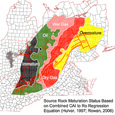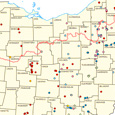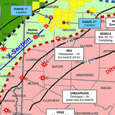Shale Boom Taxes
Thursday, December 6, 2012

By KRISTY FOSTER SEACHRIST
kfoster@farmanddairy.com
SALEM, Ohio — Now that your have your lease money and may have been paid for a pipeline easement, the next question is how do you report the taxes and figure out how much you need to pay?
Tax liabilities
David Marrison, associate professor with the Ohio State University Extension, talked about the issue at a shale conference in November.
Marrison explained that every landowner who receives lease bonus payments, or agrees to a pipeline easement, or receives royalties, has to pay taxes on the money.
The Internal Revenue Service is made aware of the payments being made through the 1099 forms filed by the company paying the landowner, so there’s no getting around the taxes.
Marrison recommends all landowners get tax advice from a certified public accountant or a tax professional if there are any questions.
Reportable income
He said all lease bonus payments are reportable as rental income. Royalties are reportable as income and the gross amount is reduced by deductions.
Payments received as compensation of damage to crops are reported to the IRS as ordinary income as well.
The pipeline easement tax reporting depends on the duration of the easement. If it is for three years, then it is treated as a rental and is considered ordinary income. If the easement is for more than 30 years, it is treated as a sale and goes on form 4797.
Marrison also discussed the sale of mineral rights on land and how it is taxed. He said that if a landowner decides to sell the mineral rights or land for an easement, then it is treated as a long-term capital gains sale for tax purposes as long as it has been owned for more than one year.
How much?
The question many landowners have after receiving bonus payments, royalties, damages or easement funds is how much should they set aside for the IRS.
Marrison said he would be conservative, and put aside more than the estimates to be sure there is enough to pay the taxes.
One example Marrison gave was for a $100,000 lease payment. He explained that the federal rate would be estimated at 25 percent and the state rate would be around 4.9 percent. He stated the landowner should save about $30,000 to pay for that tax burden.
Another possibility is if a landowner receives a $500,000 lease payment. The rate bounces into a higher category of 35 percent and 6.3 percent for the state. The taxpayer will have to pay approximately $210,000 in taxes.
Local income taxes
Marrison also warned the crowd to be wary of local income taxes. He advises checking to see if a local tax would apply, which would mean putting even more aside.
To avoid penalties, the taxpayer needs to have 100 percent of the previous year’s tax liability paid.
Marrison warned farmers could lose their estimated tax privileges if they don’t obey by the regulations for reporting shale gas income.
Ways to save
Marrison also shared some ways to save on taxes paid. They include maximizing the front of the 1040 deductions, which include increasing the IRA (Individual Retirement Account) and salary reductions, and health deductions.
He also suggested that maximizing the Schedule A deductions may help to save on taxes. He said be open to prepaying Ohio income tax and real estate taxes. And don’t forget about charitable giving.
(Reporter Kristy Foster Seachrist welcomes feedback by phone at 800-837-3419 or by e-mail at kfoster@farmanddairy.com. You can also follow her on Twitter at http://twitter.com/fosterk96.)





Please email follow ups……….